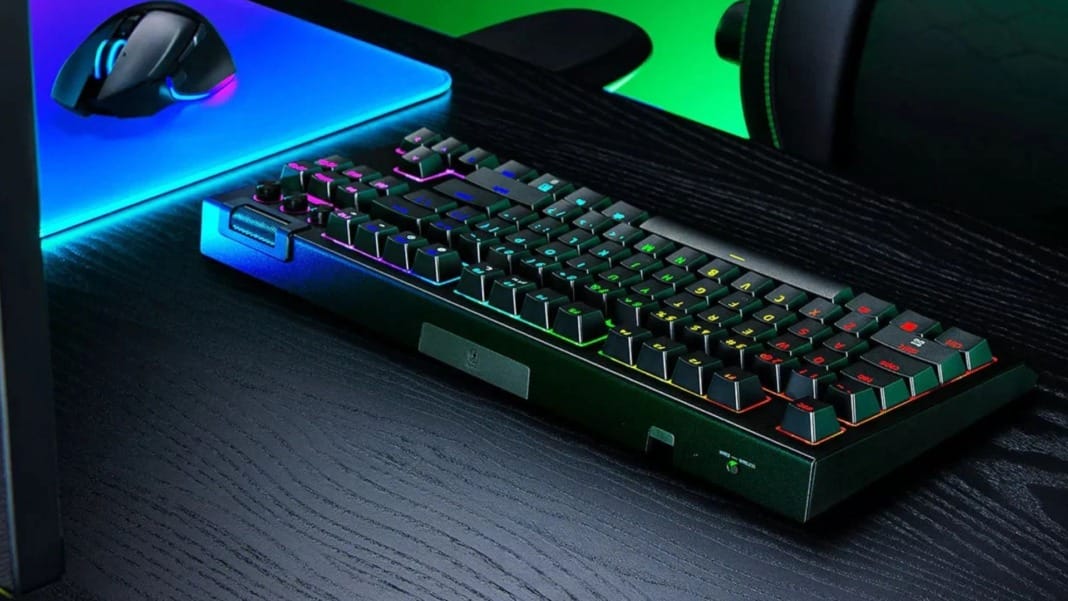If you’ve been waiting for a tenkeyless version of Razer’s popular BlackWidow V4 line, you’re in luck. Razer has now unveiled the BlackWidow V4 TKL Hyperspeed, filling the long-missing gap in its keyboard lineup. Designed for those who want a more compact keyboard without sacrificing the familiar navigation and home cluster, this new addition is packed with modern features and wireless performance.
A more compact design without compromise
Until now, Razer’s BlackWidow V4 series has not included a traditional tenkeyless (TKL) version. While the company had released 75% variants for users seeking smaller footprints, those still wanting a functional layout with arrow keys and a home cluster had limited options.
That changes with the BlackWidow V4 TKL Hyperspeed, a sleek board that combines the best features from across the series. It includes hot-swap switch support, allowing you to replace switches without the need for soldering. By default, it comes with Razer’s tactile Orange switches, but thanks to compatibility with both 3-pin and 5-pin Cherry-style switches, you can fully customise your typing experience.
Inside, Razer has pre-installed lubricated stabilisers, PCB tape, and sound-dampening foam for a quieter, smoother keystroke. If you’re a fan of screw-in stabilisers, the PCB is also compatible. The top-mounted steel plate creates a firmer typing feel, while the top half of the case is made from aluminium alloy and the bottom from ABS plastic, giving it a solid but not overly heavy build.
Wireless freedom and thoughtful extras
This new TKL board is the second BlackWidow V4 model to offer Razer’s proprietary Hyperspeed 2.4GHz wireless technology. That’s the same ultra-fast wireless connection you’ll find in Razer’s other high-end devices. Hyperspeed is claimed to be 25% faster than typical wireless setups and can handle multiple compatible devices through one USB dongle. The polling rate tops out at 1,000Hz, offering reliable performance for gaming and productivity.
If you prefer other options, the keyboard also supports Bluetooth 5.1 with pairing for up to three devices, as well as a USB-C port for wired use and charging. Battery life is a strong point—up to 980 hours in Power Saving Mode, which disables RGB lighting and reduces polling for extended use.
While the TKL Hyperspeed lacks an OLED display or Command Dial like the Pro 75% model, it still comes with a dedicated media roller and three remappable buttons for playback, volume, and battery settings. All of this is configurable in Razer Synapse, where you’ll also find full Chroma RGB control with per-key lighting and 16.8 million colour options. However, the box does not include a wrist rest, which may be a downside for some users.
Price, availability and final thoughts
The BlackWidow V4 TKL Hyperspeed is positioned slightly above the non-Pro 75% version in terms of pricing, mainly due to its wireless capabilities. At S$229, it remains significantly more affordable than the higher-end Pro versions in the V4 line. Currently, it’s available in just one black colourway, and can be found on Razer’s online store, Razer Stores, and at selected retail outlets.
If you’re seeking a compact keyboard that doesn’t sacrifice utility and offers impressive wireless performance with customisation options, this TKL release could be your ideal pick. Razer has finally brought balance to its BlackWidow V4 range—and fans of tenkeyless boards now have a solid new option.





